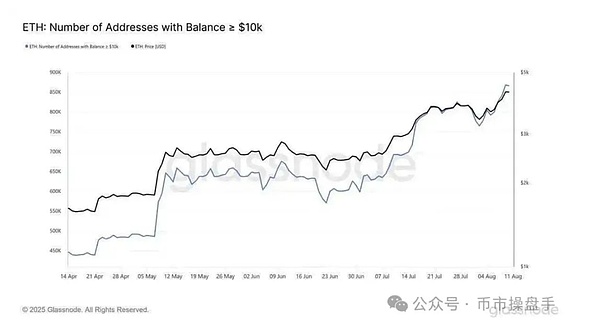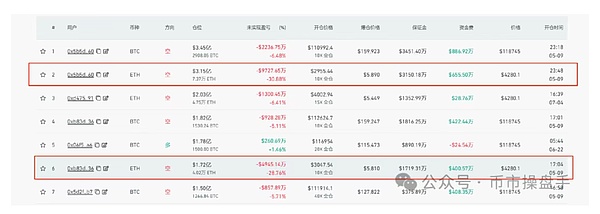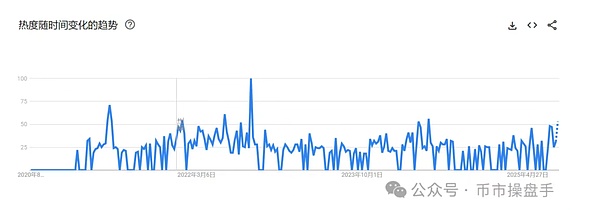
In the past four months, Ethereum has risen sharply, with prices soaring from $1,380 to $4,360, up 216%, becoming one of the world’s most impressive assets.However, it is quite abnormal that this traditional “retail investor paradise” has evolved into an institutional carnival.The latest data shows that institutional holdings are growing at an unprecedented rate – according to Strategicethreserve data, as of August 12, 70 institutional treasury and Ethereum ETFs held a total of 9.49 million ETH, accounting for 7.85% of the circulation.What’s more striking is that data on the Glassnode chain shows that this round of price increases is highly consistent with the trend of “giant whale”: when Ethereum broke through the $4,200 mark, the number of addresses holding more than 10,000 ETH soared to 868,886, a record high in the past 13 months.This series of data shows that the market structure is undergoing a fundamental change, and institutional investors have become the main driving force of this bull market.

To a certain extent, this round of Ethereum bull market can be regarded as the ultimate test for “true believers” – few investors can hold their positions in such a rapid rise.Typical cases are sad: Abraxas Capital, a veteran crypto investment institution, once bought the bottom in the range of $1,600-1,800, but locked in profits through futures hedging around $2,300, and missed the subsequent main uptrend, resulting in an ETH hedging loss of more than $140 million.What’s even more dramatic is that the co-founder of BitMEX, who has repeatedly predicted that Ethereum will break through $10,000, misjudged the market to fall below $3,000 at $3,500, and was eventually forced to cover his position at a high of $4,200.The collective misjudgment of these “market veterans” just confirms the difficulty of maintaining stability in extreme market conditions.

There is a typical cognitive bias in the current market: some “fundamentalists” simply attribute this round of Ethereum rise to capital games, citing that the price surge is not synchronized with the improvement of network indicators.This analytical framework may be established in traditional markets, but it completely misunderstands the pricing mechanism of crypto assets – in the emerging asset field, prices are not fundamental lagging indicators, but the most forward-looking catalyst.
Solana’s rise is the most convincing process: when SOL soared from $7.8 to $130, the network effect began to accelerate – the developer ecosystem exploded and the exponential growth of user volume, which eventually gave birth to the prosperity of Meme trading platforms such as Pumpfun.This path clearly confirms the unique law of the crypto market: price breakthroughs create narratives, narratives attract capital, and capital promotes ecological development.
In fact, the phenomenon of “price before fundamentals” is very common in innovative assets.Looking back on history, when Amazon’s stock price rose 194% in 2003, its PE remained negative; during the period when Tesla rose 344% in 2013, quarterly delivery volume increased by only 25%.All of these cases show that disruptive technology assets often go through an “expected-driven” price discovery phase.
For Ethereum, the current price increase is only the first round of value revaluation driven by the dual positive effects of the GENIUS Act regulatory framework and the “Project Crypto” institutionalization strategy.This round of market mainly reflects policy expectations, while substantial market conditions based on improvements in network fundamentals (such as growth in GAS consumption and increasing TVL scale) are still brewing.But we must be clear that the current price reflects the market’s expectations for the future.When the on-chain indicators improve significantly, it often means that market expectations have been fully priced and the market may have come to an end.
For a large number of investors who miss the opportunity, the current difficult choice is: whether to buy it!Although we do not recommend chasing the rise, from the perspective of trend, the current risk of buying is not high, and there are two main reasons:
1. Once a trend is formed, it often has extremely strong inertia – it is difficult to reverse unless you experience sufficient bullish catharsis.As long as the rise does not go through a stage of accelerated volume, there is little chance that the market will peak in the short term.
2. Every bull market is inseparable from the participation of retail investors. They often have to go through four psychological stages: waiting period (doubting the authenticity of the market) → hesitation period (being afraid of missing out on opportunities and being afraid of pullbacks) → position building period (buying in batches while anxious) → fanatic period (chasing highs for all positions).Currently, Google’s “Ethereum” search popularity is only 40% of its historical peak, and the on-chain small-address holdings are growing slowly (not reaching the distribution stage), and the rise of Ethereum has not been widely discussed by social media. These signs indicate that retail investors have not entered the market on a large scale, and the market is likely to be in the second stage.

Although there is no need to be afraid of highs in the trend, you should still avoid chasing the rise in operations. When buying, you should try to choose when the market is inserted – after all, there are many sharp drops in bull markets (the sharp drop in the day is the buying point), and only by lowering the average price of building positions can you maximize returns.







